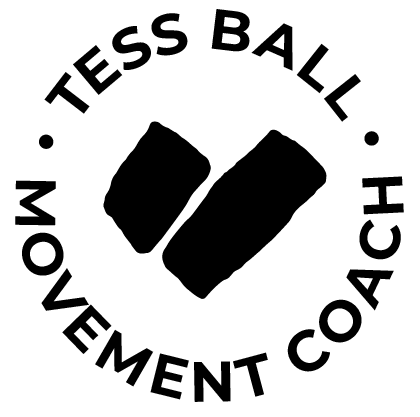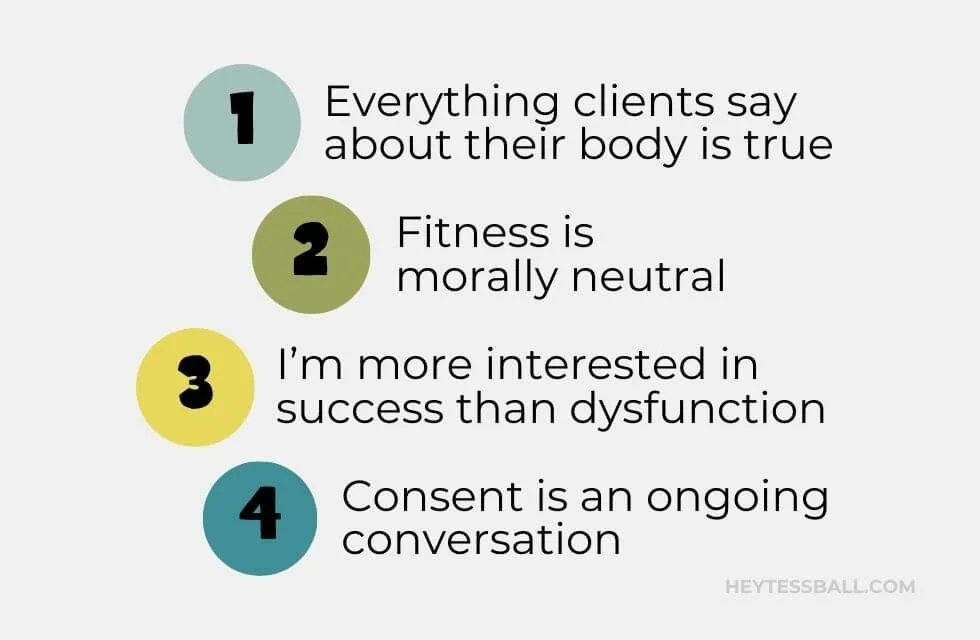Trauma-Informed Coaching: Cueing (Part 3 of 5)
Welcome to Part Three of our 5 Relationship Checkpoints for Trauma-Informed Fitness Coaching series! If you haven’t had a chance to look over Part One or Part Two, I recommend giving them a quick read first, as they lay a strong foundation for everything we’ll cover today. Here’s a quick refresher on the five checkpoints:
Initial Consult – Creating a safe and supportive entry point for folks with trauma histories
Program Design – Incorporating trauma-informed practices into goal-setting, programming, and celebrations
Cueing – Empowering clients to set boundaries and communicate their needs
Policies – Building a foundation of trust and transparency
Marketing – Using shame-free messaging to attract (and retain) the right clients
A quick disclaimer: I’m not a mental health professional. I’m a coach with lived experience of C-PTSD and ADHD, plus years of teaching under my belt. These strategies have worked for me and my community. As someone who’s personally navigated trauma, I wish more fitness spaces took this approach—because when done well, it fosters the kind of meaningful coach-client relationship that keeps people coming back. Let’s dive in.
Cueing: Empowering Clients to Own Their Experience
At its heart, trauma-informed coaching is about creating space for clients to reconnect with their bodies and reclaim a sense of agency over their own experiences. Trauma can rob people of bodily autonomy, so your role is to support them in voicing what they want and setting boundaries. It’s all about safety, trust, and truly listening.
A major way we facilitate this as coaches is through communication and cuing. We could spend months discussing the nuances of trauma-informed communication, but let’s zoom out and look at four core beliefs that guide how I cue my clients:
Everything clients say about their body is true.
Fitness is morally neutral.
I’m more interested in success than dysfunction.
Consent is an ongoing, essential conversation.
Let’s explore how each of these shows up in practice.
1. Everything Clients Say About Their Body Is True
In a coaching relationship, believing your client’s experience is non-negotiable and invaluable, establishing a foundation of trust and validation. Many trauma survivors have been dismissed or disbelieved in the past, so trust is fragile.
When you take their words at face value you send a powerful message: “I hear you, and I believe you.”
A new coach once asked me, “What if they say they can’t squat because they’ve got tiny ducks swimming in their belly?”
My response:
Which way do those ducks have to swim to bring them into better squat alignment?
What happens to the ducks when they brace their core or use hardstyle breath?
Can they describe that sensation for me?
It’s funny, but it makes a serious point: we meet clients where they are and respect their perspective. I take what they say at face value because my role in this interaction is to help them move better.
You’ll hear “I can’t do it” or “This is hard” a lot. Believe them. “Can’t” might signal their nervous system is on high alert, or maybe they’re worried about aggravating an old injury. Rather than saying, “Oh, you got this,” or "Come on, just one more rep,” offer an alternative or ask how you can make it feel safer. That’s how you build rapport and help clients learn to advocate for themselves.
Pro Tip: If someone says, “This is really tough,” I’ll respond, “Of course it's hard, you didn't come to the gym to do easy stuff.” Then I might say, “On a scale from 1 to 10, how tough?” That gives us a tangible way to adjust or collaborate without dismissing their experience and ensuring they feel heard.
Remember, if someone’s nervous system is saying “no,” that’s real, even if physically you know they can handle more. As a trauma-informed coach, your job is to give their body—and brain—the space to catch up.
2. Fitness Is Morally Neutral
No deadlift or pull-up makes someone a better person. A consistent gym routine doesn't mean someone's figured out the meaning of life.
As coaches, we must acknowledge just how much of our language, especially in fitness, is rooted in a good/bad binary. We assume people want to lose weight because thin is "good." We vilify food groups, we idolize "leaving it all on the gym floor," and we treat injury as a moral failing.
But let’s not forget this important fact . . . fitness is just fitness. It’s not a moral code, and there isn’t a universally “good” or “bad” way to move.
By stripping away judgmental words, you make room for trust, growth, and genuine joy—free from the moral baggage that often follows people into the gym. Remember, movement can be a tool for health, strength, community, or mental well-being.
3. I’m More Interested in Success Than Dysfunction
Let’s be honest: a lot of our coach training involves looking for dysfunction—knees caving in, hyperlordosis, flat feet, you name it. And yes, we need to stay mindful of safety. But if we only focus on what’s “wrong,” we miss the chance to celebrate what’s going right.
Example: If a client dials in their deadlift breathing, celebrate it. If they remember every step of a Turkish Get-Up, give them a proper shout-out. If they finally engage their glutes in a plank, tell them how awesome that is.
Why It Matters: Trauma survivors often exist in a loop of self-doubt. Recognizing even their small wins reminds them they’re capable and resilient. It can spark motivation and deepen the trust between you both—powerful positive reinforcement that says, “I see how hard you’re working, and it’s amazing.”
When clients feel good about their progress, they seek more of that feeling and it empowers them to keep going. This positive reinforcement enhances motivation and strengthens the alliance between coach and client. Your genuine celebration becomes a catalyst for cultivating trust and collaboration.
4. Consent Is an Ongoing, Essential Conversation
In a truly trauma-informed space, consent isn’t a one-time checkbox. It’s an ongoing dialogue—especially if your coaching style includes hands-on cues or close physical proximity.
Consent in trauma-informed fitness coaching establishes a foundation of safety, trust, and respect between the coach and the client. For trauma survivors, the body can be a sensitive and triggering space due to past experiences. Cuing exercises with explicit consent ensures clients have agency over their bodies throughout the coaching process. This approach acknowledges their autonomy and empowers them to make choices that are right for them.
Here are some practical examples of how you might check in with clients:
“May I put my hand on your back, between your shoulder blades?”
“May I invade your space a little bit to bring you this kettlebell?”
“Will you put this strap around your knee while I hold the other end of it?”
By consistently asking for consent, you enable clients to stay in control of their own bodies. For individuals with trauma histories—where bodily autonomy may have been compromised—this is essential in preventing re-traumatization, creating a supportive training environment, and showing genuine respect for personal boundaries. That sense of safety and autonomy serves as the backbone of a positive coaching relationship.
Wrapping Up & Looking Ahead
When you cue in a trauma-informed way, you’re not just helping people move their bodies—you’re validating their experiences, boosting them with positive reinforcement, and empowering them to maintain agency throughout the session. That’s a game-changer for trauma survivors, and honestly, for anyone who’s ever felt uneasy in a fitness environment.
Next, we’ll examine how Policies can either support or undermine these goals. Here’s what’s on deck for the final two posts:
Policies – Crafting guidelines that build trust and transparency
Marketing – Using shame-free messaging to attract the right clients
For more updates, follow me on Instagram or TikTok. I’ll be sharing new posts in this series, along with a few random rants, cat videos, and the occasional kettlebell trick.
Now go out there and create a safer, stronger, and more honest relationship with your clients—because if you want people to stick around, you have to give a damn about their whole experience, not just their sets and reps.
Lift heavy, love each other well, and keep doing the hard, meaningful work!
—Tess




